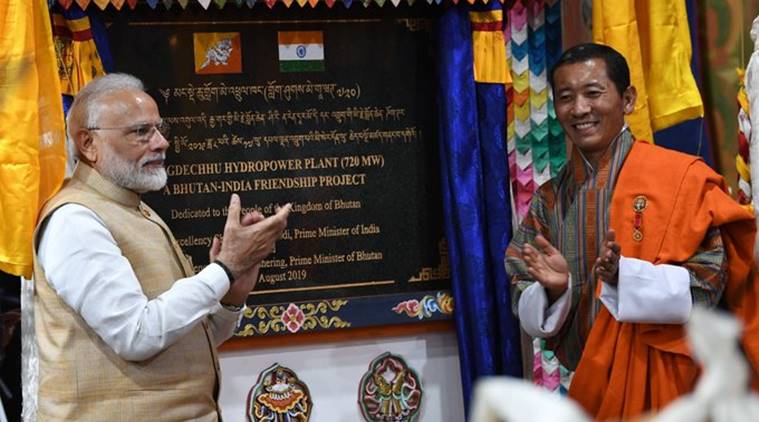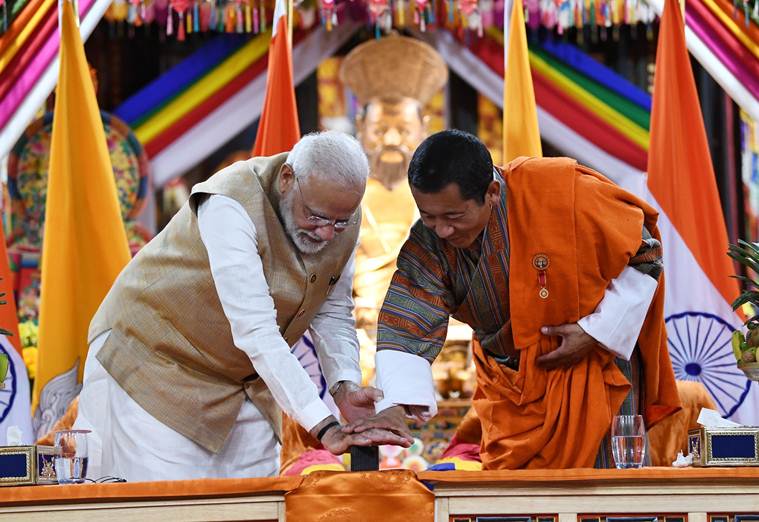
As Prime Minister Narendra Modi inaugurated the Mangdechhu hydroelectric power plant in Bhutan Saturday, on this side of the border, there was a sense of irony.
In 2010, the year in which the 720 MW Mangdechhu Project was appraised, the Detailed Project Report (DPR) for a project of similar size was wrapped up on the Indian side of the border — the 520 MW Teesta IV project in Sikkim. But despite starting off the blocks together exactly nine years ago, while Mangdechhu’s first unit has now come on stream, Teesta IV still remains on the drawing board.
This is despite Teesta IV being developed by a state-owned utility in India even as Mangdechhu, one of the major projects under Bhutan’s initiative to generate 10,000 MW hydropower by 2020 with India’s support, is being developed almost entirely by Indian utilities in a foreign country.
NHPC LTD, the state-owned company executing the project, currently brackets the Teesta IV project in the “awaiting clearances” category. Incidentally, NHPC was the design and engineering consultant for the Mangdechhu hydropower project while Jaiprakash Associates was contracted for the construction of the dam, diversion tunnels, underground powerhouse, shafts and the intake structures and another state-owned company, Bharat Heavy Electricals Ltd, supplied the four 180 MW turbines for the project in Bhutan.
The reason for Teesta IV not taking off is attributed to NHPC not managing to get the requisite clearances in time and the FRA (clearance under Forest Rights Act) not getting done.

Such is the frustration with the lack of progress that a senior company official, while deposing before a parliamentary panel late last year, contrasted the state of progress of both projects.
Delays in projects such as Teesta IV also bring into focus the role of state governments in committing to expediting clearances. In the case of Teesta IV, NHPC has not been able to hold FRA meetings “on one pretext or the other,’’ an official indicated. “With great difficulty”, now the utility has come up to the level that in all the gram panchayat units, meetings have been held.
Of the 10 GPUs, it is only in two GPUs where 50 per cent of the people have said they do not want the project whereas in an overwhelming eight GPUs, almost 100 per cent people have said that this project must come up, officials indicated. Despite that, the project is hanging fire.
The fate of Teesta IV is not an isolated one.
Up to the mid-1960s, the share of hydropower as a proportion of India’s overall installed electricity generation capacity was 46 per cent which meant that nearly one in two units powering the country’s electricity grid was a hydro unit. Half a century later, despite the advancement in civil engineering technology and the increasing pressure on governments to reduce the country’s carbon footprint by harnessing clean energy sources, hydropower’s share has plummeted to under 15 per cent, a record low.
The continuing slide comes despite the NDA government’s stated resolve to increase the share of renewables in the country’s overall energy mix, something that is focused overwhelmingly on solar and, to some extent, wind power.

A scaling up the share of the hydel sector in the country’s overall energy mix is seen as an important pre-requisite in counterbalancing the massive deployment of other renewable capacity. A higher hydel generation in the energy mix makes it easier for grid managers to adjust to the vagaries of solar and wind generation on a daily basis. According to government data updated till April 2018, there are at least 19 hydro power projects in India that are facing time over-runs of five or more years.
The broad support for Teesta IV at the gram panchayat primarily stems from another project done just downstream — Teesta V. Following the execution of the project, the Singtam town, a small village before this project came up, scaled up into a full-fledged big town.
The Rs 4,500-crore hydroelectric plant in central Bhutan, presented as a Bhutan-India friendship project, is a run-of-river power plant built on the Mangdechhu River in Trongsa Dzongkhag district of the Himalayan nation. It was developed by the Mangdechhu Hydroelectric Project Authority, jointly constituted by the Indian and the Bhutanese governments. Construction of the hydropower project began in June 2012 and the first of the four units of the power plant was commissioned in June 2019.
Most of the electricity generated by the Mangdechhu hydropower project will meet the energy requirements of Bhutan and the surplus electricity will be exported to India. The produced electricity is transmitted to the Jigmeling substation in Bhutan by way of two 80-km-long 400kV double-circuit transmission lines. Electricity to the Indian grid would be transmitted from Jigmeling in Bhutan to Salakati in Assam.
India and Bhutan signed a protocol in April 2019, formalising the tariff at Rs 2.4 per unit (kWh) for a period of 35 years. The tariff will be increased by 10 per cent every five years until the loan is repaid and 5 per cent thereafter.